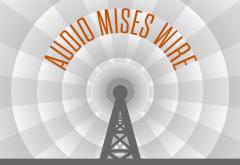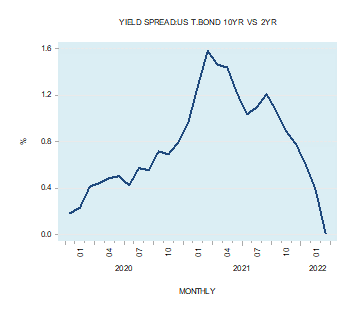On April 19, 2022, at the Economic Club in New York, the Chicago Federal Reserve Bank president Charles Evans said the Fed is likely to lift by year end its federal funds rate target range close to the neutral range of between 2.25 to 2.50 percent. Furthermore, on April 21, 2022, Fed chairman Jerome Powell corroborated this by stating that the Fed wants to raise its benchmark rate to the neutral level. By popular thinking, the neutral rate is one that is consistent with stable prices and a balanced economy. Hence, in order to attain economic and price stability, Fed policy makers should navigate the federal funds rate toward the neutral rate range. The Swedish economist Knut Wicksell in the late nineteenth century articulated this framework of thinking, which has
Topics:
Frank Shostak considers the following as important: 6b) Mises.org, Featured, newsletter
This could be interesting, too:
RIA Team writes The Importance of Emergency Funds in Retirement Planning
Nachrichten Ticker - www.finanzen.ch writes Gesetzesvorschlag in Arizona: Wird Bitcoin bald zur Staatsreserve?
Nachrichten Ticker - www.finanzen.ch writes So bewegen sich Bitcoin & Co. heute
Nachrichten Ticker - www.finanzen.ch writes Aktueller Marktbericht zu Bitcoin & Co.
 On April 19, 2022, at the Economic Club in New York, the Chicago Federal Reserve Bank president Charles Evans said the Fed is likely to lift by year end its federal funds rate target range close to the neutral range of between 2.25 to 2.50 percent. Furthermore, on April 21, 2022, Fed chairman Jerome Powell corroborated this by stating that the Fed wants to raise its benchmark rate to the neutral level.
On April 19, 2022, at the Economic Club in New York, the Chicago Federal Reserve Bank president Charles Evans said the Fed is likely to lift by year end its federal funds rate target range close to the neutral range of between 2.25 to 2.50 percent. Furthermore, on April 21, 2022, Fed chairman Jerome Powell corroborated this by stating that the Fed wants to raise its benchmark rate to the neutral level.
By popular thinking, the neutral rate is one that is consistent with stable prices and a balanced economy. Hence, in order to attain economic and price stability, Fed policy makers should navigate the federal funds rate toward the neutral rate range. The Swedish economist Knut Wicksell in the late nineteenth century articulated this framework of thinking, which has its origins in the eighteenth-century writings of the British economist Henry Thornton.
One can assume that the current framework of central bank operations throughout the world is based to a large degree on Wicksell’s writings, which means the key to comprehending the rationale of central banks actions is understanding the writings of Knut Wicksell.
The Neutral Interest Rate Framework
According to Wicksell the neutral rate is (Wicksell labels the neutral rate as the natural rate):
A certain rate of interest on loans which is neutral in respect to commodity prices, and tend neither to raise nor to lower them. This is necessarily the same as the rate of interest which would be determined by supply and demand if no use were made of money and all lending were effected in the form of real capital goods. It comes to much the same thing to describe it as the current value of the natural rate of interest on capital.
In this way of thinking, the neutral rate of interest is defined as the rate at which the demand for physical loan capital coincides with the supply of savings expressed in physical magnitudes.1 Wicksell makes a clear distinction between the interest rate that is determined in financial markets and the neutral interest rate that is set without money. While the interest rate in financial markets is determined by demand and supply for money, the neutral interest rate is set by real factors. Thus, he wrote:
Now if money is loaned at this same rate of interest, it serves as nothing more than a cloak to cover a procedure which, from the purely formal point of view, could have been carried on equally well without it. The conditions of economic equilibrium are fulfilled in precisely the same manner.
According to the neutral rate framework, the main source of economic instability is because the money market interest rate is not in line with the neutral rate. In the Wicksell’s framework, money only affects the price level. The effect of money on the price level is however not direct, as it operates via the gap between the money market interest rate and the neutral rate. The mechanism works as following: if the market rate falls below the neutral rate, investment will exceed saving implying that aggregate demand will be greater than aggregate supply.
Assuming that the excess demand is financed by the expansion in bank loans this leads to the creation of new money, which in turn pushes the general level of prices up. Conversely, if the market rate rises above the neutral rate, savings will exceed investment, aggregate supply will exceed aggregate demand, bank loans and the stock of money will contract, and prices will fall (on this topic, see this Fed working paper). Whenever the market rate is in line with the neutral rate, the economy is in a state of equilibrium and there is neither upward nor downward pressures on the price level.
According to Wicksell:
If it were possible to ascertain and specify the current value of the natural rate, it would be seen that any deviation of the actual money rate from this natural rate is connected with rising or falling prices according as the deviation is downward or upward.
Wicksell held that since the supply of real capital is limited while the supply of money can be regarded as elastic, there is no reason to assume that the money market interest rate would normally agree with the neutral real rate.2 Furthermore, Wicksell maintained that to establish whether monetary policy is tight or loose, it is not enough to pay attention to the level of money market interest rates, but rather one needs to contrast money market interest rates with the neutral rate. Thus if the market interest rate is above the neutral rate then the policy stance is tight. Conversely, if the market rate is below the neutral rate then the policy stance is loose. Thus, according to Wicksell, whenever the money market rate is matched with the neutral rate the economy is in a state of equilibrium and there are neither upward nor downward pressure on the price level.
Can Real Interest Rates Be Identified?
Observe that in Wicksell’s framework the equilibrium or neutral interest rate is the real short-term interest rate, which is consistent with stable prices. However, would it be possible in a world without money, such as presented by Wicksell, to establish interest rate? For instance, can one establish the interest rate on the lending of present apples in return for potatoes in the future?
In a world without money, all that one could ascertain is the quantity of present goods exchanged for the quantity of various future goods. For instance, one present apple is exchanged for two potatoes in one year’s time. Alternatively, one present shirt is exchanged for three tomatoes in one year’s time. There is, however, no way to establish the interest rate that a lender of an apple receives from a borrower of this apple that repays the loan by means of potatoes. It is not possible to calculate the interest rate on the loan since potatoes and apples are not the same goods. Likewise, we cannot establish the interest rate on the lending of the shirt for future tomatoes. We can only establish that one present shirt is exchanged for three future tomatoes. However, we cannot ascertain the interest rate. Only in the framework of money can one establish the interest rate. The following example provides an illustration of this interest rate formation.
According to the time preference of John the baker he will be ready to lend ten dollars—which he has earned by selling ten loaves of bread—to a borrower who promises to repay eleven dollars in one year’s time. Also, according to the time preference of Bob the shoemaker, he will be willing to borrow ten dollars at an interest rate of 10 percent. Once the deal is accomplished, both parties to this deal have benefited. The baker will get eleven dollars in one year’s time that he values much more than his present ten dollars. For the shoemaker the value of the present ten dollars exceeds the value of eleven dollars that he is expected to repay in one year’s time.
In this situation, both monetary and real factors (time preferences) are involved in establishing the market interest rate, which is 10 percent. Note that the baker has exchanged ten loaves of bread for money first, which is ten dollars. He then exchanges the ten dollars for eleven dollars to be paid back in a year. The interest rate that he secures for himself is 10 percent, which means the shoemaker has agreed to borrow at that rate.
Observe that without the existence of money—the medium of exchange—the baker is not able to establish how many future goods he must be paid for his ten loaves of bread that will correspond to the rate of interest of 10 percent. Now, if the rate of interest cannot be established in the absence of money it would be absurd to lend money without any connection to goods and services—after all the role of money is to facilitate the exchange of goods and services. Consequently, there cannot be any separation between real and financial market interest rates. There is only one interest rate, which is set by the interaction between individuals’ time preferences and the supply and demand for money.
For instance, with an increase in individuals’ wealth, they are likely to lower their time preferences. A decline in time preference implies the increase in individuals’ willingness to invest in various assets. As a result, this is going to lower individuals’ demand for money. Consequently, this is going to lift assets prices and lower assets yields.
Because the influences of changes in the demand and supply for money and individuals’ time preferences are intertwined, it is impossible to isolate and quantify these influences on interest rates. Hence, the commonly accepted practice of calculating the real interest rate by subtracting percentage changes in the consumer price index from the market interest rate is flawed. So if the real interest rate cannot be ascertained it follows that the neutral interest rate cannot be established either.
Furthermore, in the mainstream framework, the neutral interest rate is formed at the point of the intersection of supply and demand curves. The supply and demand curves as presented by mainstream economics originates from the imaginary construction of economists. None of the figures that underpin these curves originate in the real world; they are purely imaginary. According to Ludwig von Mises, “It is important to realize that we do not have any knowledge or experience concerning the shape of such curves.”
Consequently, this implies that it is not possible to establish from the imaginary curves the neutral interest rate. How then can one tell whether the market interest rate is above or below the neutral rate? Wicksell suggested that policy makers pay close attention to changes in the price level. A rising price level would call for an upward adjustment in the interest rate, while a falling price level would signal that the interest rate should be lowered.
Following the Wicksellian framework, once a gap between the money market interest rate and the neutral rate is closed the central bank must actively ensure that the gap does not emerge again. In that framework, a monetary policy that maintains the equality between the two rates becomes a factor of stability. Most experts hold that once the Fed has managed to bring the federal funds rate to the neutral rate then this must mean that the economy is in a state of equilibrium.
In order to extract the unobservable neutral interest rate, economists employ sophisticated mathematical methods. However, this brings us to this important question: Does all of this really make sense?
The Fed is trying to establish the interest rate that corresponds to the conditions of the free market, which obviously contradicts principles of the free market. In a free market in the absence of central bank monetary policies, the interest rates that emerge would be truly neutral. In a free market, no one would be required to establish whether the interest rate is above or below some imaginary equilibrium. The state of equilibrium in the context of conscious and purposeful behavior has nothing to do with the imaginary equilibrium as depicted by popular economics. Equilibrium is established when individuals’ ends are met. When a supplier sells his supply at a price that yields profit, one can say he has reached an equilibrium. Similarly, consumers who bought this supply have done so in order to meet their goals, making equilibrium a subjective state of things, not an objective one.
Information on the Neutral Rate Cannot Help Achieve Stability
Even if the Fed had the information of where the neutral rate should be, it could not achieve economic stability because the Fed will be forced to add or subtract money in order to keep the market rate in line with the neutral rate. Such action, unfortunately, leads to boom-bust cycles and economic instability.
Hence, there cannot be such thing as the neutral interest rate policy that can result in economic and price stability. Rather than targeting the money market interest rate toward the unknown neutral rate by means of monetary tampering—which itself leads to more instability—a better alternative is to not intervene at all. In the absence of central bank monetary policies, interest rates that emerge will be authentically neutral.
Summary and Conclusion
The idea of the neutral interest rate is unrealistic. The Fed attempts to establish an interest rate that corresponds to the conditions of the free market. Obviously, this is in contradiction to the free market, since in a free market there is no central bank setting the interest rate.
Given the impossible goal that the Fed tries to reach, we do not expect Fed policy makers to become wise and all knowing with regard to the correct level of interest rates. A better alternative is to leave the economy alone.
- 1. Karl Pribram, A History of Economic Reasoning (Baltimore: Johns Hopkins University Press,1983), p. 322.
- 2. Pribram, A History of Economic Reasoning, p. 323.
Tags: Featured,newsletter








